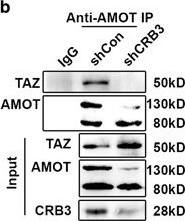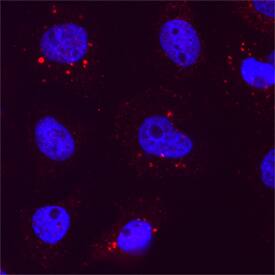Human TAZ/WWTR1 Antibody
R&D Systems, part of Bio-Techne | Catalog # MAB7210

Key Product Details
Species Reactivity
Validated:
Cited:
Applications
Validated:
Cited:
Label
Antibody Source
Product Specifications
Immunogen
Met267-Leu400
Accession # Q9GZV5
Specificity
Clonality
Host
Isotype
Scientific Data Images for Human TAZ/WWTR1 Antibody
Detection of Human TAZ/WWTR1 by Western Blot.
Western blot shows lysates of A431 human epithelial carcinoma cell line and HeLa human cervical epithelial carcinoma cell line. PVDF membrane was probed with 2 µg/mL of Mouse Anti-Human TAZ/WWTR1 Monoclonal Antibody (Catalog # MAB7210) followed by HRP-conjugated Anti-Mouse IgG Secondary Antibody (Catalog # HAF007). A specific band was detected for TAZ/WWTR1 at approximately 50 kDa (as indicated). This experiment was conducted under reducing conditions and using Immunoblot Buffer Group 1.TAZ/WWTR1 in BG01V Human Embryonic Stem Cells.
TAZ/WWTR1 was detected in immersion fixed BG01V human embryonic stem cells using Mouse Anti-Human TAZ/WWTR1 Monoclonal Antibody (Catalog # MAB7210) at 10 µg/mL for 3 hours at room temperature. Cells were stained using the NorthernLights™ 557-conjugated Anti-Mouse IgG Secondary Antibody (red, upper panel; Catalog # NL007) and counterstained with DAPI (blue, lower panel). Specific staining was localized to nuclei and cytoplasm. View our protocol for Fluorescent ICC Staining of Cells on Coverslips.Detection of Human TAZ/WWTR1 by Western Blot
Downregulation of CRB3 confers CSC traits on breast cancer cells through the TAZ/ beta-catenin cascade. (a) Western blot detecting the expressions of AMOT, TAZ and beta-catenin. (b) CoIP/western blot analysis showing endogenous AMOT bound to TAZ. (c) Fluorescence-activated cell sorting of CD44high/CD24low population. (d) Western blot of TAZ and stem cell markers. (e, g) Representative images and quantification of formed mammospheres. (f) Western blot of beta-catenin and stem cell markers. XAV939 was used to inhibit beta-catenin. (h) Flow cytometry analysis of the stem cell marker ALDH and the CD44high/CD24low population. All data are presented as mean±s.e.m. and statistical significance was calculated using a two-tailed t-test. Image collected and cropped by CiteAb from the following publication (https://pubmed.ncbi.nlm.nih.gov/28436991), licensed under a CC-BY license. Not internally tested by R&D Systems.Applications for Human TAZ/WWTR1 Antibody
Immunocytochemistry
Sample: Immersion fixed BG01V human embryonic stem cells and A431 human epithelial carcinoma cell line
Western Blot
Sample: A431 human epithelial carcinoma cell line and HeLa human cervical epithelial carcinoma cell line
Reviewed Applications
Read 1 review rated 5 using MAB7210 in the following applications:
Formulation, Preparation, and Storage
Purification
Reconstitution
Formulation
Shipping
Stability & Storage
- 12 months from date of receipt, -20 to -70 °C as supplied.
- 1 month, 2 to 8 °C under sterile conditions after reconstitution.
- 6 months, -20 to -70 °C under sterile conditions after reconstitution.
Background: TAZ/WWTR1
TAZ (Transcriptional co-Activatorr with PDZ-binding motif; also WWTR1) is a 50-55 kDa protein that is related to YAP65 TEF-1 interacting protein. It is a widely expressed transcriptional coactivator, and should not be confused with tafazzin/Taz, an enzyme associated with lipid metabolism. TAZ influences the nuclear transport of SMAD-2, -3 and -4, and in the nucleus, TAZ is known to interact with transcription factors such as TFF1, Pax8, NKX2-1 and TEADS, serving as a scaffold for transcriptional activation complexes. Human TAZ is 400 amino acids (aa) in length. It contains one WW domain (aa 124-157) that binds to PPXY motifs, a coiled-coil region (aa 225-259), and a PDZ binding domain (aa 394-400). There are at least four utilized phosphorylation sites. When phosphorylated on Ser89, TAZ preferentially bind to 14-3-3 proteins, promoting its retention in the cytoplasm. Over aa 267-400, human TAZ shares 88% aa identity with mouse TAZ.
Long Name
Alternate Names
Gene Symbol
UniProt
Additional TAZ/WWTR1 Products
Product Documents for Human TAZ/WWTR1 Antibody
Product Specific Notices for Human TAZ/WWTR1 Antibody
For research use only



